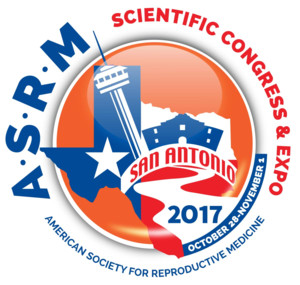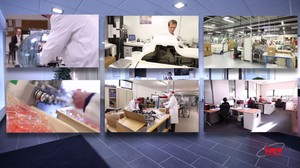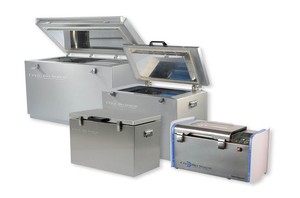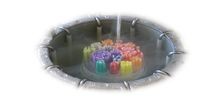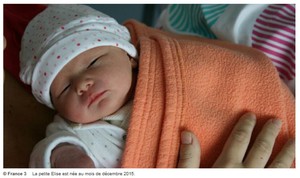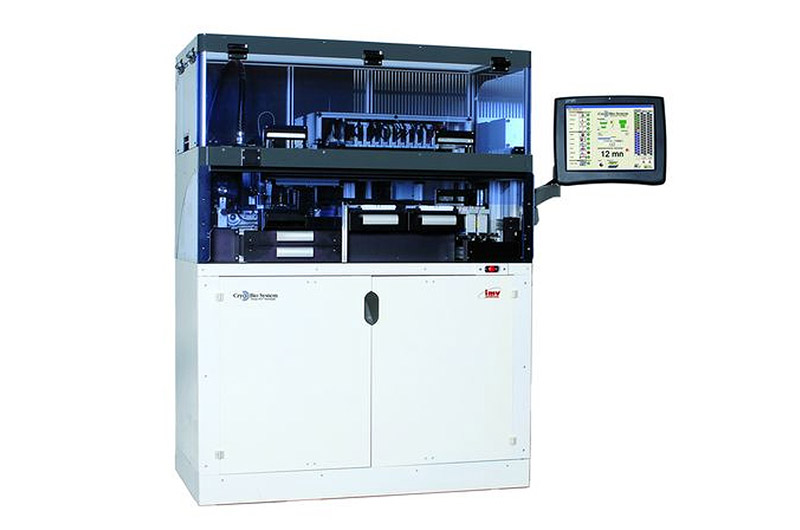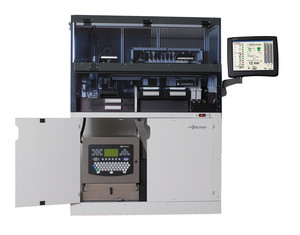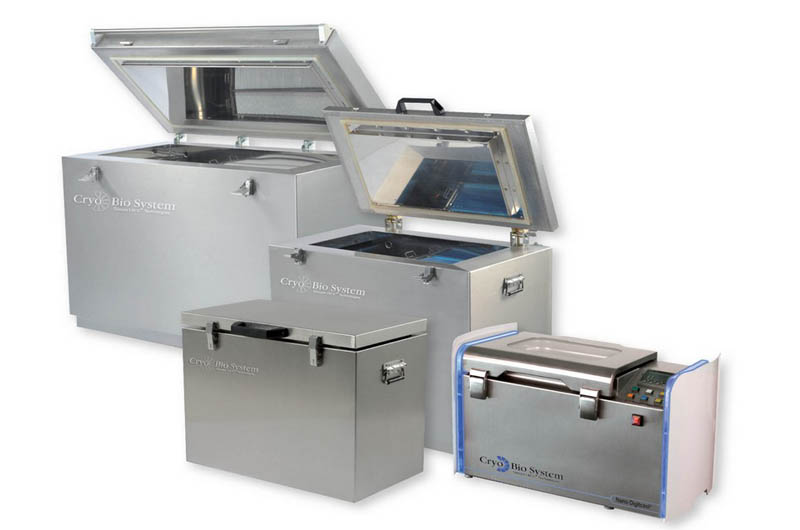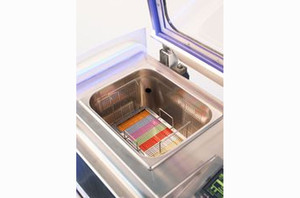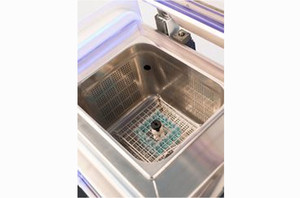ASRM 2017 (American Society for Reproductive Medicine)
October 28 – November 1
San Antonio
Booth 543
Month: April 2018
Global Biobank Week September 2017
Global Biobank Week
September 13-15 2017
Booth 19 bis
Stockholm, Sweden
IMV Technologies online
freezers are used for cryopreservation
These freezers are used for cryopreservation for all types of biological products.
In France in 2014, Clamart CTSA’s (French Military Blood Transfusion Center) and Rennes EFS (French Blood Service) Cell Therapy laboratories, INRA (French National Institute for Agricultural Research) research laboratory in Gyf sur Yvette, Servier laboratory in Croissy/Seine and American Hospital in Paris, trusted us and we thank them!
the latest addition to our range of freezers:
Perfect traceability
Excellent homogeneity chamber temperature
Straws and tubes freezing with manual or automatic seeding
Remote viewing freezing steps
IMV Technologies obtained the highest accreditation awarded
IMV Technologies obtained the highest accreditation awarded by the customs authorities – AEO-F (“Authorized Economic Operator-Full”). This is a major step forward for our customers and partners as we will benefit from a faster and more reliable delivery process!
This internationally mutual recognition agreement of AEO is a key element to facilitates cross-border controls and procedures. It recognizes customs compliance, appropriate record-keeping, financial solvency and appropriate security and safety standards.
This agreement was obtained for three of our companies: Cryo Bio System, Cryovet and IMV Technologies. From a security point of view, this represents a considerable advantage since imports and exports will be AEO certified, meaning local customs should grant the use of simplification procedures when possible.
This certification, awarded by the customs authorities, confirms that the IMV Technologies group of companies is reliable internationally with regards to customs regulations, security and safety.
Compressor based mechanical freezers
The ubiquitous -80°C freezer is, without a doubt, the workhorse freezer of cryopreservation labs across the world. Rows and rows of these freezers are lined up in labs, research areas, hospitals, universities, bio banks and more, humming round-the-clock, day-in and day-out. Protecting and preserving countless samples of irreplaceable specimens is their mien, proud soldiers on the front lines of research.
Compressor based mechanical freezers such as the -80ºC certainly have their benefits. They also have a few major drawbacks that many lab managers and supervisors are well aware of. Mechanical freezers for cryopreservation utilize power, a lot of power, like any other freezer, to maintain the given temperature parameters for the storage of the specimens contained within. Mechanical freezer manufacturers assert that a uniform low temperature in their freezers provides the same reliability as their counter part, an LN2 system. Part of this may be true, but at what expense can mechanical freezers make this claim. Mechanical freezers are just that, mechanical. They, like hard drives, will fail at some point for any variety of reasons. Electrical power loss, compressor failure, motor failure, or more will quickly take a freezers required freeze temperature down very quickly, and, in the cryopreservation industry, failure is not an option. It has been reported that the probability of failure in a mechanical freezer is 1:100 to 1:1,000 while the probability of failure in an LN2 system is 1:10,000 to 1:100,000, that’s a 100-to-1 ratio.
Mechanical freezers have long been the paradigm for cryogenic storage facilities, but few are ready to admit that they are challenging their own fate. In 2012, a major Boston brain bank repository had a failure event that caused one-third of their stored brain specimens to be rendered useless. The loss of this priceless collection was said to have pushed back research on a variety of brain disorders at least ten years. That same year, a freezer failure in Chicago lost the sperm samples of forty individuals, resulting in not only millions of dollars of monetary damages, but also a resulting negative public and professional perception. The list and incidences of mechanical freezer failures is long and unfortunately has its blemishes, but despite technological advances, they will unfortunately continue. Lab directors worldwide are acutely aware of the possible, and maybe imminent, dangers of mechanical freezers.
Lab directors are also constantly reminded how much it costs to keep these freezers running. Depending on the model, size, and manufacturer, mechanical freezers are expensive to run just by their very nature. In most labs with a redundant emergency plan in place, a freezer will require a dedicated 120 amp circuit, drawing power around the clock, 24/7/365. Additional alarms, backup systems, monitoring devices and more electrical needs also drive the power needs and electric costs up. Additionally, because mechanical freezers throw off a large amount of heat, interior climate control costs have to be factored in. A recent self-assessment report conducted at The Mayo Clinic reported that it would cost upwards of $100,000 to keep 150 upright -80º freezers up and running, and that doesn’t factor in other ambient power needs. Just as lab directors are looking at power needs and costs, so too are state and federal environmental agencies.
California’s Global Warming Solutions Act – the harbinger of global warming policies, was launched in 2006 and brought into full force in January of 2013, has become the most extensive mandate for carbon dioxide emissions control regulations in the US. Originally aimed at large manufacturers, power plants, and other high-energy users, the act was a comprehensive set of carbon-cap guidelines that has now been adopted by many other states as well as the Environmental Protection Agency. Recently as part of the over-arching policies, the focus of these agencies has been moving towards a second tier of high-energy users, specifically, data centers, marijuana growers and most importantly, cryogenic storage facilities. While these market sectors are not considered manufacturers, they are by their nature grouped together in an auspicious category of high-energy users. State and federal regulators are now looking closely at these entities and are requiring a new set of standards and practices for labs to reduce their power usage. Cryogenic storage manufacturers have already begun to address the issue of reducing the energy consumption in their products, but many ask if that’s a viable long-term solution.
Many forward thinking labs are already adopting plans to convert their mechanical freezers over to safer, less power hungry freezer systems that utilize either liquid LN2 or vapor phase storage. In many cases, storage facilities already have a number of LN2 freezers in their labs as a backup system for if, or when, a mechanical freezer malfunctions, allowing for exposed specimens to be manually removed and safely stored until repairs or replacement can be made. This backup plan does have it’s own drawbacks. The process of removing vial boxes from drawers in the freezer takes precious time that exposes the specimens to ambient temperatures that may further degenerate the integrity of the specimens. If a lab has a number of freezers that are affected, the process can literally take hours to transfer specimens from a mechanical freezer to an LN2 freezer from the racks they reside in. A new rack and frame system developed by ColdStash helps speed up the process because the vial boxes are snuggly self-contained, allowing for whole drawers of boxes to be transported as opposed to individual boxes. The transition from one freezer to the other is seamless, and can be a long-term permanent solution for storage, but it doesn’t completely address the need for labs to convert their freezer storage methodologies.
While many labs are looking at the inevitable change over from mechanical freezers to an LN2 system, the change may be hampered by the cost of new freezers and how aggressive state and federal agencies clamp down on new regulations. Today’s need to minimize carbon emissions and reduce ozone damage means it is important to ensure that any laboratory is as environmentally friendly as possible. Therefore, providing equipment for long-term low-temperature storage that requires minimal energy without emitting any noise or heat pollution enables researchers to concentrate on the complexities of the freezing process with the knowledge that their cryogenic experiments are extremely environmentally friendly. Liquid nitrogen storage enables convenient in-lab placement with no noise or heat pollution. Furthermore, they maintain low temperatures for very long storage periods without consuming electricity. This cost-effective method not only saves on laboratory resources, maintains a higher level of specimen security, reduces carbon emissions, but also is extremely friendly to the environment.
Tim Claflin
President
OneTen Communications Group
Saunderstown RI
A 29 year old patient with Hodgkin’s lymphoma
A 29 year old patient with Hodgkin’s lymphoma preserved her fertility through oocyte vitrification* before the start of her chemotherapy.
She was healed two years after the end of the treatment, but had premature ovarian failure. In vitro fertilization on the warmed oocytes enabled the first French birth by oocyte vitrification within the background of cancer.
The first baby conceived using the DNA
The first baby conceived using the DNA of three individuals in the embryo was born last April. An international medical team used an unprecedented technique that involves transferring the genetic material from the nucleus to prevent transmission of the mother’s defective genes that cause Leigh syndrome.
The physicians transferred genetic material containing the mother’s chromosomes to a donor’s egg whose genetic material had been removed. The technique that was performed in Mexico by Dr. Zhang was presented at the ASRM annual conference that was be held in October in Salt Lake City, Utah, which Cryo Bio System was attending.
diva
DIVA
Automated system for identifying, filling and sealing CBS™ High Security Straws
Description / Use
Starting from a batch of up to 96 primary sample tubes, DIVA automatically performs the functions of aliquoting each tube into CBS™ High Security 0.5 mL straws of different color according to the user protocol, sealing the straws, and printing and validating the aliquot identification (barcode GS1 128 and/or alphanumerical ID) on every straw.
A sorting system separates the straws according to the different colored compartments (visotubes) in which they will be stored inside the Daisy goblets.
DIVA proactively manages the consumables needed for a given production cycle. A production cycle with 2 straws per primary sample tube for instance allows an autonomy of 1h 08min without operator intervention. Refilling of consumables can be done “on the run”, without interrupting the cycle, allowing for 100% continuous workflow operation. The operator is informed in real time of the cycle progression (including estimated time left to completion), as well as the level of consumables left on the machine and when to replenish consumables and/or primary tubes.
DIVA is a fully automated platform for packaging specimens into straws. As such, it features:
- An embedded computer running the pilot software to manage all the cycle functions and security features.
- A touch screen used for the user interface to define the protocols and input information.
The system offers the possibility to print out protocols and production reports. Through various communication ports, DIVA offers connectivity within a network and data exchange with any Laboratory Inventory Management System (LIMS).
The flexibility of the pilot software allows to manage several protocols, all with adequate security features in conformity with Good Laboratory Practices: information such identification of protocol author and user, etc., are systematically recorded and attached to final production reports.
Positive identification of the straws can be achieved in different formats: barcode GS1 128 and/or alphanumerical code. At minima, the straw ID can be the replica of the primary sample tube ID.
Full traceability between “mother” primary tubes and “daughter” straw aliquots is ensured through an automated bar code scanning input module that read the bar codes of all primary sample tubes on the rack and an automated bar code scanning output module that validates the bar code printed on the straws.
The throughput of the system (# straws/minute) is directly linked to the aliquoting protocol (# aliquots/primary tube).
Note : DIVA can advantageously be extended with the Straw IT storage management software.
Technical Specifications
Standard starting time, maintenance and shut-down: 15 minutes a day.
All parts potentially contaminated can be easily cleaned with alcohol or a liquid non-corrosive decontaminant.
DIVA System
- L x W x H: 1208 x 660 x 1600 mm
- Weight: 100 kg without printer (220 lb)
- Electrical consumption: 400 W
- Power Supply: 110 or 220 V / 60 or 50 Hz
- Range of working temperatures: +15℃ to +32℃ (+59℉ to +90℉)
- Maximum elevation: 2,000 m
- Relative humidity: 80% at +32℃ (+90℉)
| Reference | Description |
|---|---|
| 020984 | DIVA, automatic aliquoting, identification, filling and sealing of CBS™ High Security straws – with Domino printer 230 V / 50 Hz – CE |
| 020983 | DIVA, automatic aliquoting, identification, filling and sealing of CBS™ High Security straws – without printer 230 V / 50 Hz – CE |
digitcool controlled
Digitcool Controlled Rate Freezers
Description
Controlled-rate freezing of all biological products (eg. plasma, all blood cells, human tissues, gametes). The stainless steel Digitcool freezer is fully programmable and easy to disinfect.
- Temperature range: -150℃ to +50℃ (-238℉ to +122℉) (-180℃ reachable depending on the total sample volume)
- Cooling rate: 0.1 to 60℃/min
- Automatic reheating, drying and return to room temperature at end of cycle
- Hot/cold regulator programmer (4 programs of 8 segments and 8 ramps in memory)
- Temperature measured by PT 100 ohm probes (chamber and product)
- Digital temperature display (chamber, product, program)
- Can be connected to a computer terminal and a printer
- Regulation based on “chamber” temperature
- Liquid nitrogen dispensed through a self pressurized reservoir with 120 or 220 liters capacity
Advantages
- Freezing racks for 0.25 or 0.5 mL straws
- Distribution blocks for 0.25 or 0.5 mL straws
- Software
- Filter unit
- 120 L self pressurized tank
Accessories
| Digitcool | Mini-Digitcool | Micro-Digitcool | Nano-Digitcool | |
|---|---|---|---|---|
| Outside dimensions | 46×31.5×39.4″ | 30.3×20.1×28.7″ | 23.6x15x20.5″ | 28.4×18.7×18.5″ |
| Weight | 130 kg (287 lb) | 58 kg (128 lb) | 38 kg (84 lb) | 55 kg (121 lb) |
| Chamber inside dimensions | 37.8×18.5×12.6″ | 25.2×12.6×16.5″ | 19.3×12.8×9″ | 9.4x7x7.8″ |
| Chamber volume | 150 L | 90 L | 26 L | 11.5 L |
| Sample capacity | 3,000 CBS straws | 1,392 CBS straws | 240 CBS straws | 33 CBS straws |
| Power (Heater) | 2500W | 2000W | 1000W | 1200W |
| Voltage / Frequency | 220V/50Hz/16A | 220V/50Hz/10A | 220V/50Hz/6A | 220V/50Hz/6A |


